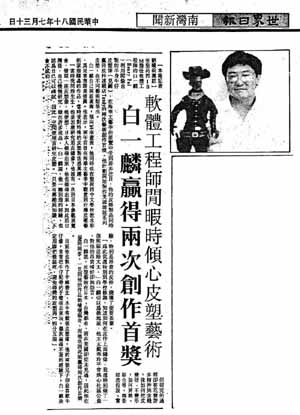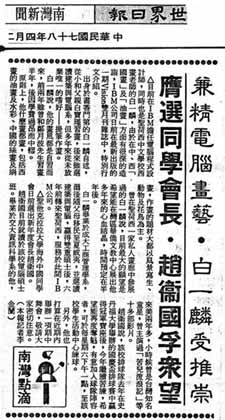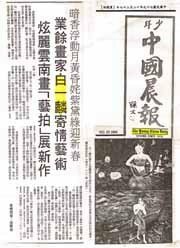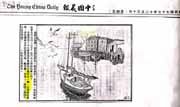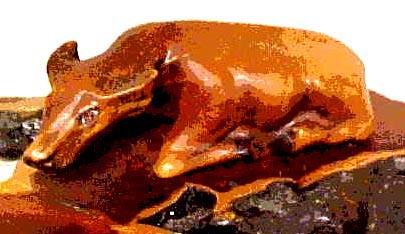 from, Nov. 1 through Dec. 31.
Pai immigrated from Taiwan to the United States, where he attended the
University of Hawaii, Honolulu. There he received his Master of Science
in Architecture design and computer science.
from, Nov. 1 through Dec. 31.
Pai immigrated from Taiwan to the United States, where he attended the
University of Hawaii, Honolulu. There he received his Master of Science
in Architecture design and computer science.
Henry Pai, an artist, IBM programmer, and weekend art teacher in the
Almaden Valley, recently won first prize in the Tandy leather contest
with his unique leather creations, and will be featured at an Art beat
Gallery exhibit and reception at El Apse de Sara toga shopping center
 from, Nov. 1 through Dec. 31.
Pai immigrated from Taiwan to the United States, where he attended the
University of Hawaii, Honolulu. There he received his Master of Science
in Architecture design and computer science.
from, Nov. 1 through Dec. 31.
Pai immigrated from Taiwan to the United States, where he attended the
University of Hawaii, Honolulu. There he received his Master of Science
in Architecture design and computer science.
After working for Boeing company in Seattle for five years, Pai moved to Almaden Valley eight years ago.

A member of the local Fine Art League, Pai has been an artist since childhood. His paintings are mostly acrylic on silk in the fashion of "Yunnan School," a colorful, modern and popular Chinese art form that is abstract in combination with realism.
According to Pal, he went to Tandy Leather Co. to learn about leather working one year ago, and has since been mastering single piece leather figures that are virtually unknown as an art form in the United States. 'I Keep getting better. It took me a long time to figure out the intricacies," he said.
Although Pai started with animal figures like water buffalo, he likes to make people now, because [he] can express moods and feelings." ==============================================================================
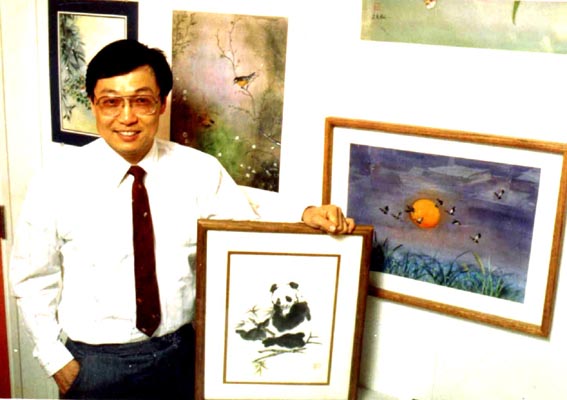
By Bennett Karmin
from IBM "Vision volume2 1989 "
It is said that inside of every programmer, there's an artist struggling to get out. Certainly the two disciplines are not as dissimilar as some may think. There is artistry and elegance to a well-crafted computer program. Perhaps that's why programmers frequently relax by painting or writing in their off hours.
Henry Pai is such a programmer. To dispel the occasional frustrations of his work, Pai pursues his lifelong hobby of painting in the traditional Chinese style, a style which emphasizes the expression of the inner spirit over realism. ("A painting should be a spontaneous and instantaneous flow of the brush," said the Chinese philosopher Wing-Tsit Chan.)
Pai creates one or two paintings each week, mostly in a converted studio at home, where he frequently works from 7 p.m. till 1 a.m. Such a regimen may sound fatiguing, but Pai finds it relaxing. It allows him to put aside the demands of his work as an IMS Staff programmer. Using such basic materials as brush and ink, with a few quick strokes he creates canvasses of fluttering birds or swaying flowers.
"With oriental art," says Pai, "you already have a picture of what you intend to paint in your mind before you paint it. Even before that first brush stroke you have a pretty good idea of how it will look. Once that picture is firmly impressed in your mind, you can combine it with mental images of other pictures, other scenes. The thinking takes time, but the actual painting process goes very quickly. This is the Chinese tradition.
"Before you even start, you're advised to research the subject. Then you practice making Chinese characters for a period of time. Chinese characters are ideograms similar to pictures. The letter for a tree actually looks something like a tree. If you can draw these characters, you're off to a good start.
Pai sees similarities between his art and computer programming. "Both programmer and painter strive for zero defects in their work," he points out. "Of course, with painting, your mistakes are fixed forever for all to see, ecause once a painting is finished, you don't have the opportunity to test and correct your errors."
Westerners think of painting as a solitary art. But ancient Chinese art was sometimes a collective undertaking, much like today's programming.
"There is a famous Chinese painting 200 years old," says Pai, "showing a province extending from the Yellow River in the east to somewhere around Tibet in the west. It took a dozen artists months to draw, on orders from the emperor. There was a head artist who, like today's program manager, had to supervise everyone connected with the project. Some artists just painted ships; others the river, and so forth. When it was done, the mural was 30 feet long and a foot wide.
"Creating such a painting would be something like organizing a large group of programmers to work on a project. Both need careful organization and forethought if they are to be executed correctly.
While growing up in Taipei, Pai studied with a famous artist whose works are now exhibited in the Chinese National Museum on Taiwan and in many other museums throughout Southeast Asia. Like his mentor, Pai primarily paints in black and white and uses up to eight different values or shadings to indicate variations in color.
"In Western art, you're more creative in the beginning," Pai notes. "Right off, you start painting a scene or subject. If you follow someone else's style, you're called a copycat. But Oriental art is different. Whoever can imitate the old masters at the beginning most likely will become famous later on."
While most of Pal's work is in Chinese brush drawing, a taxing and demanding medium in which one mistake can ruin a painting irreparably, he has used oils and acrylics when working with paper and traditional Chinese silk screens.
On Saturdays, Pai teaches Chinese art at John Muir Junior High School. A number of his pupils are the children of IBM employees.
Pal's sister is a professional painter who operates her own gallery in Honolulu. And in keeping with family tradition, Pal's 9 year-old son, Matthew, is learning to paint and already has won prizes for his drawings.
Pai has sold a number of paintings to friends and co-workers, and his drawings have been exhibited in a San Jose gallery. His work will soon be displayed as part of a Chinese art exhibit in San Francisco. But he still takes lessons from his venerable teacher, whom he refers to as "the master," an 83-year-old traditionalist.
"My master says that if you want to draw something, you have to draw it better than the original," Pai says. "if your drawing is exactly like the original, you might as well take a photograph. We don't need that. You have to make your subjects or scenes prettier than they look. You don't draw details line by line. You draw a mood. Remember, your new paintings should always please yourself first. ================================================================================
OTHER REFERENCES:
Art published at "New Art International" year:2001
Click to see enlarge version:
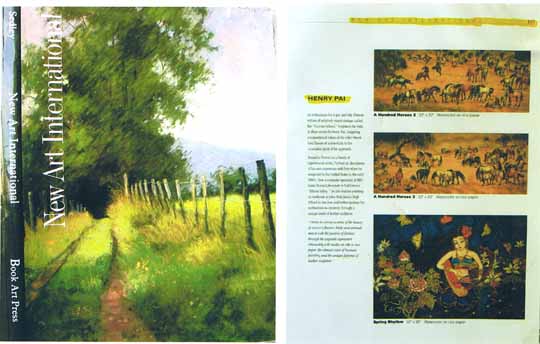
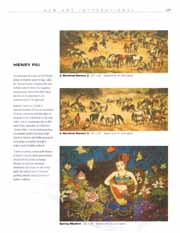 Other Chinese News/Articles:
===============================================================================
===============================================================================
Other Chinese News/Articles:
===============================================================================
===============================================================================
